Using Software in Qualitative Research
A Step-by-Step Guide
Student Resources
Chapter 6 - Working at Data Level (QDA Miner)
Chapter 6 in the book is all about working at data-level. Being immersed in the data for most researchers is part of familiarising with and analysing the data. You may need this before coding or to enrich and substantiate the coding process (chaps 7 – 9). Remaining close to the data will be more important for some researchers, but for all, the functions covered may be key analytic processes to many different approaches to qualitative data analysis. See all coloured illustrations (from the book) of software tasks and functions, numbered in chapter order.
Sections included in the chapter:
Annotating
Marking data
Data reduction
Text searching
Word frequencies
Text mining
Hyperlinking between points in the data
How to attach comments to the whole project or parts of it
QDA Miner offers several memo tools.
- Some text may be attached to the entire project by pressing the F4 key
- One can also attach comments to specific cases by creating additional document variables
- One can also attach comments to various outputs stored in the Report Manager
- Log entries in the command log window. This section focuses on how to attach comments to coded segments
- Attach comments to code segments
To attach a comment to a coded segment
SUGGESTIONS ABOUT CODES AS A WAY TO KEEP YOU AT DATA LEVEL
- Think how the coding process can be used as a way to just ‘mark’ data for later retrieval
- It can be used as a way to mark relevance or to enable you to focus on reducing data which has significance for limited number of broad indicators (or themes) e.g. “relevant”, “not relevant” “highly significant”
- Further commenting at those places in the data helps to enrich your understanding and recall of what is important in particular segments of the data
REMINDER: The code creation process is discussed in the previous section. To assign a code to text simply select the relevant text passage and double click on the required code.
- Select the coded segment to which you want to attach a comment by clicking its code mark
- Click a second time to display the shortcut menu
- Select the COMMENT command. A small window like the one below will appear
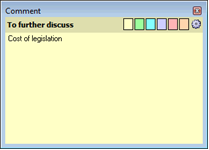
- Enter the text that you want to associate with the selected code segment
- Click the X button (in the upper-right corner) to save the comment and to close the window
You can choose among six types of comments by clicking one of the color rectangles in the upper-right corner of the dialog box (each color corresponds to a different comment type). The labels associated with those comment types appear in the upper-left corner of this window and may be customized by clicking the ![]() button.
button.
When a note has been assigned to a coded segment, a small square with the corresponding color is displayed in the middle of the code bracket. To edit an existing code, follow the same steps described above. To remove a comment, simply open the Note Editor and delete all text in the editing window.
Comments attached to coded segments can be previewed by hovering the mouse cursor over the code mark.
TIP: While comments cannot be attached to a document itself or to an image, one may achieve a functionally similar feature by creating a 'Comment' or 'Memo' code used for holding any note or observation one may have.
EXPLORING TEXT: by using text search and pattern matching tools
Useful for finding topics and identifying similarity in text segments
In QDA Miner, there are many ways to interrogate coding and content of the data.
There are simple Text retrieval tools, and also pattern matching devices which are useful for identifying similarity in text segments for very large data corpus – used here to find repetitious topics and phrases in the news media in Case B, the Financial Downturn project.
- Text Retrieval (see Chapter 13 sections)
- Pattern matching Query by Example – see below (also discussed again in Chapter 13).
- Phrase Finder (using WordStat add-on)
- Further advanced quantitative analyses of content frequencies, cross tabulations etc., at the push of a button when using the add-on the WordStat module
Explore Text using QDA Miner (WordStat add-on software not required)
How to ‘Query by Example’ (pattern matching)
One of the advanced content analysis features which relies only on QDA Miner is the Query by Example tool
This is illustrated below. It uses pattern matching to allow the user to select a key passage – sentence, paragraph or just phrase and by using the Query by Example tool discover similar passages in the rest of the data.
Select a short passage of data (as here… “estate agents temporarily closed two offices”)
from Retrieval menu – select Query by Example – see dialogue box below
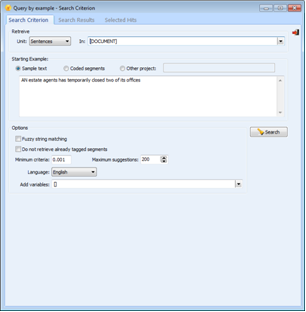
Along the top line (above) usually you would choose the Sentence or Paragraph Unit of text to retrieve – and opt to search ‘In’ the ‘Document’ (type of data or variable)
You can experiment with other options in the dialogue box but you are now in a position to hit the Search icon in the dialogue box.
See below the list of ‘Suggestions’ which results… and in the vertical column to the left you can select the examples that fit – with one click or by a second click – reject them.
If you then Choose the ‘Selected Hits’ button you can add a code to the results if required:
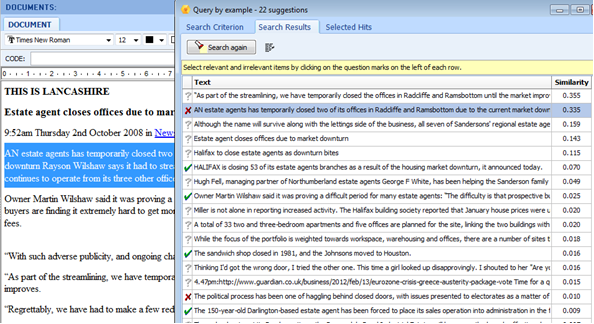
The Phrase Finder
The Query by Example tool above allows you to dictate an approximate ‘topic’ that you are interested in. The Phrase Finder on the other hand finds exact repeats of any phrases i.e. not topic specific in order to track down a sense prevalent jargon or ways of expressing things. (This only works when the add-on WordStat add-on module has been purchased)
The most common phrases can be automatically extract using the WordStat content analysis module. To extract phrases from all news transcripts, follow those procedures:
- Run the CONTENT ANALYSIS command from the ANALYSIS menu. The following dialog should appear:
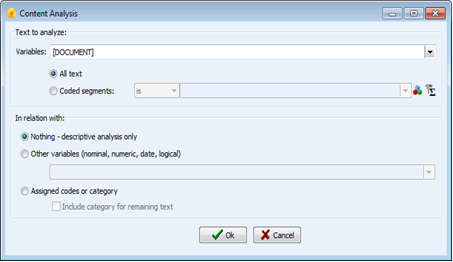
- In the Text to Analyse section, select the document variable containing the news transcript and make sure the All Text radio button is checked
- Set the In relation with option to Nothing – descriptive analysis only and click OK to starts WordStat
- On the Dictionaries page of WordStat, set the Exclusion option to English and enable it by putting a check mark beside it. Make sure that the Preprocessing and the Substitution options are disabled
- Move to the Phrase Finder page. At the top of this page, you set the options as showed below:
![]()
This setting will extract phrases containing from 2 to 5 words appearing at least three times.
- To perform the phrase extraction, click the
 button
button - Phrases will be listed by default in descending order of frequency
- [optional] Other buttons on the tool bar may be used to perform hierarchical clustering or correspondence analysis on those phrases, identify overlaps, obtain a keyword-in-context of specific phrases or filter phrases on specific words
LINKING PASSAGES OF DATA: How to create, edit, use and delete links
Hyperlinking allows one to attach to a specific text segment or coded segment a link to another part of the project or to some external resources. For example, one may use such a feature to link an example illustrating a fact or an idea to other examples corroborating or contradicting this first example, or to recreate a sequence of events over time by connecting successive events. The QDA Miner hyperlink feature may also be used to associate a coded segment to a specific geographic location or a specific time, allowing one to locate an event both in space and time.
Six types of hyperlinks are available in QDA Miner, allowing one to associate a piece of information with:
- a web page;
- a file on your computer system or available on your network;
- a geographic location (with optional time information);
- a time tag or time range;
- another case;
- a text or a coded segment
To add a hyperlink to a text segment (document variables only)
- Select the text to which you want to attach a hyperlink
- Right-click to display the shortcut menu and select the ADD command from the HYPERLINK menu item
NOTE: Because of the way hyperlinks are stored in the document, they cannot include the start or the end of a coded segment. For this reason, when such a text segment is selected, the command to create a hyperlink is disabled. An alternative solution is to attach the hyperlink to a code rather than to the text itself.
To add a hyperlink to a coded segment (document and image variables)
- Select the coded segment to which you want to attach a link by clicking its code mark
- Click a second time to display the shortcut menu
- Select the ADD command from the HYPERLINK menu item
A dialog box like this one will appear:
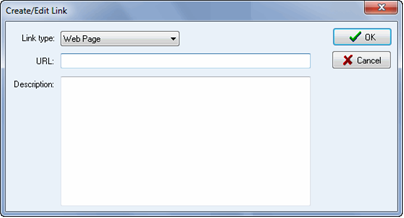
The Link Type list box allows you to specify which type of link to create. While the available options in this dialog box may differ depending on the selected link type, all link types share a common option that allows one to enter a Description. This edit box can retain the reasons why such a link was created, specify the nature of the relationship between the source and the target items, or add any comment. One may also type in some keywords that may later be searched for using the Link Retrieval feature.
The following section describes the specific options and data requirements associated with the different types of links. Geographic links will be discussed in a separate section.
Web Page
URL – This option lets you specify the URL of the web page you would like to associate with the selected item. In order to be recognized as a web link, the http:// or https:// prefixes should be included. The most convenient way to write a web URL is by opening the desired web page, copying the address from the URL box that appears at the top of the browser, and pasting it into the URL edit box.
External File
File – This option lets you type in a file name you would like to have associated with the selected item. This file may be a document, an image, a video or any other type of file, including executable applications. Clicking the ![]() button allows you to browse through your computer to locate the desired file. Once the file is selected, its full path appears in the edit box. The OK button used to confirm the creation of the hyperlink will only be enabled if the typed file name points to an existing file.
button allows you to browse through your computer to locate the desired file. Once the file is selected, its full path appears in the edit box. The OK button used to confirm the creation of the hyperlink will only be enabled if the typed file name points to an existing file.
Geographic Location
See Geo-Tagging Documents and Images
Time Stamp or Range
This type of link may be used to attach a specific time tag or time interval to the selected text or coded segment, allowing one to later perform coding retrieval based on dates or create timelines representing a sequence of events over time. The Label option may be used to store a single-line description of this event. The Date option is used to specify the basic date and time information. To specify a time range rather than a single time point, check the To box and then set the ending date and time.
An Icon may also be associated with a time stamp or time range. This icon may later be displayed in timelines created by QDA Miner. You can change the icon of a specific time link by clicking the Icon button to the right of the dialog box and by choosing a new icon from a palette. QDA Miner allows one to choose among available Google Earth icons or offers the option to create your own icon.
NOTE: While clicking other types of links causes QDA Miner to move to another location or another application, clicking a time stamp or range link has no effect. Links with dates may, however, be searched based on date intervals.
Another Case
To create a link to another case, you first need to select it by clicking the
![]()
button. You will be presented with a dialog box showing a list of all cases. Select the case you want to point to and click OK. The case description will automatically be stored in the Case edit box. This description can be edited to provide additional information.
Text or Coded Segments
Creating a link to another text or coded segment is done in a two-step process:
Step 1. Set the source segment
- Choose the text or coded segment to which the link should be attached and run the HYPERLINK | ADD command
- Set the link type to Text or Coded Segment
- Enter a description (optional) and then click OK. You will be returned to the main QDA Miner screen
Step 2. Set the destination segment
- Move to the segment where the source segment should point
- Select it and run the HYPERLINK | SET AS DESTINATION command from the contextual menu
You will be asked whether you want to create a link back to the source. Selecting Yes will attach a second hyperlink to the destination segment that will point to the original segment, allowing you to jump back and forth between the two locations. Selecting No will create a single link from the source segment to the destination segment.
To edit a hyperlink
- For hyperlinks associated with a coded segment, select its code mark from the right margin of the document (for images, you can also select from the bottom margin). For hyperlinks associated with a text segment, position the editing cursor anywhere within the text
- Right-click to display the shortcut menu and select the EDIT command from the HYPERLINK menu item. Close the dialog box when finished editing. Note that it is not possible to change the hyperlink type with the EDIT command. To perform such a change, the hyperlink must be deleted and recreated
To delete a hyperlink
- For hyperlinks associated with a coded segment, select its code mark in the right margin of the document. For hyperlinks associated with a text segment, position the editing cursor anywhere within the text
- Right-click to display the shortcut menu and select the DELETE command from the HYPERLINK menu item
To follow a hyperlink
- Move the mouse cursor over the code mark or the coded segment containing the hyperlink
- Hold the Control key down and click the link. One may also right-click to display the shortcut menu and select the FOLLOW LINK command from the HYPERLINK menu item
Normand Peladeau 2014
